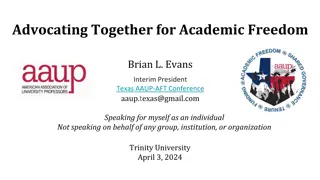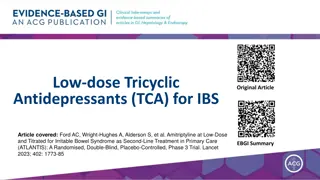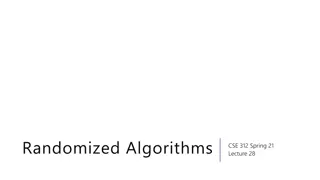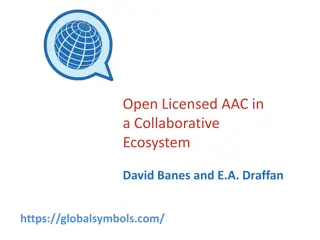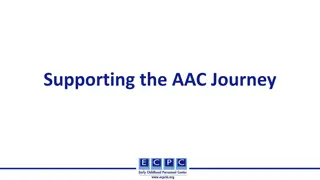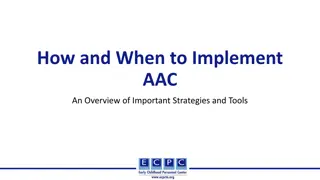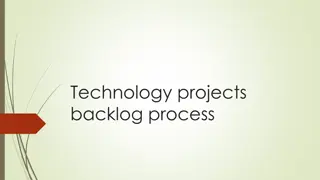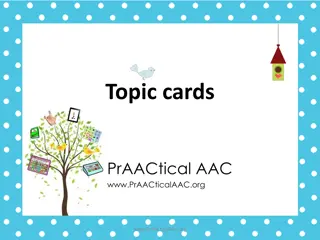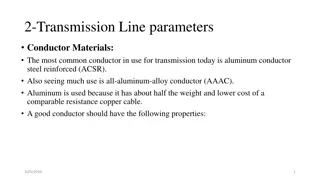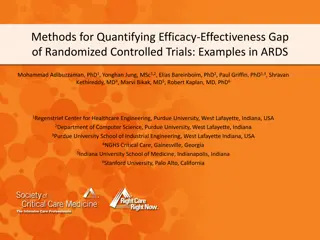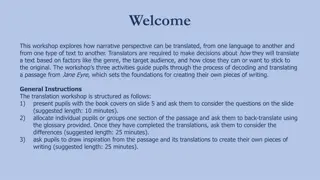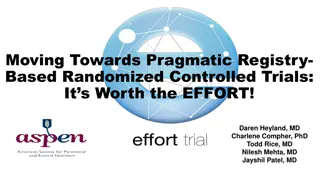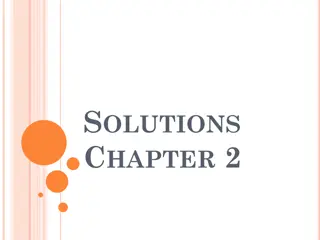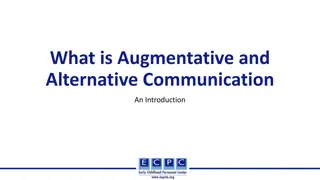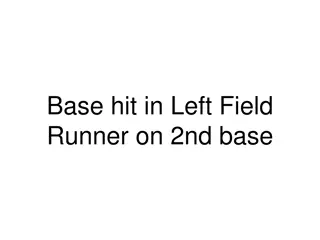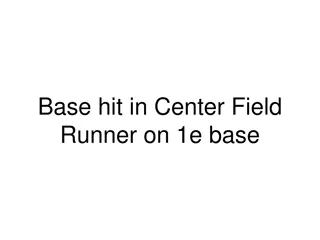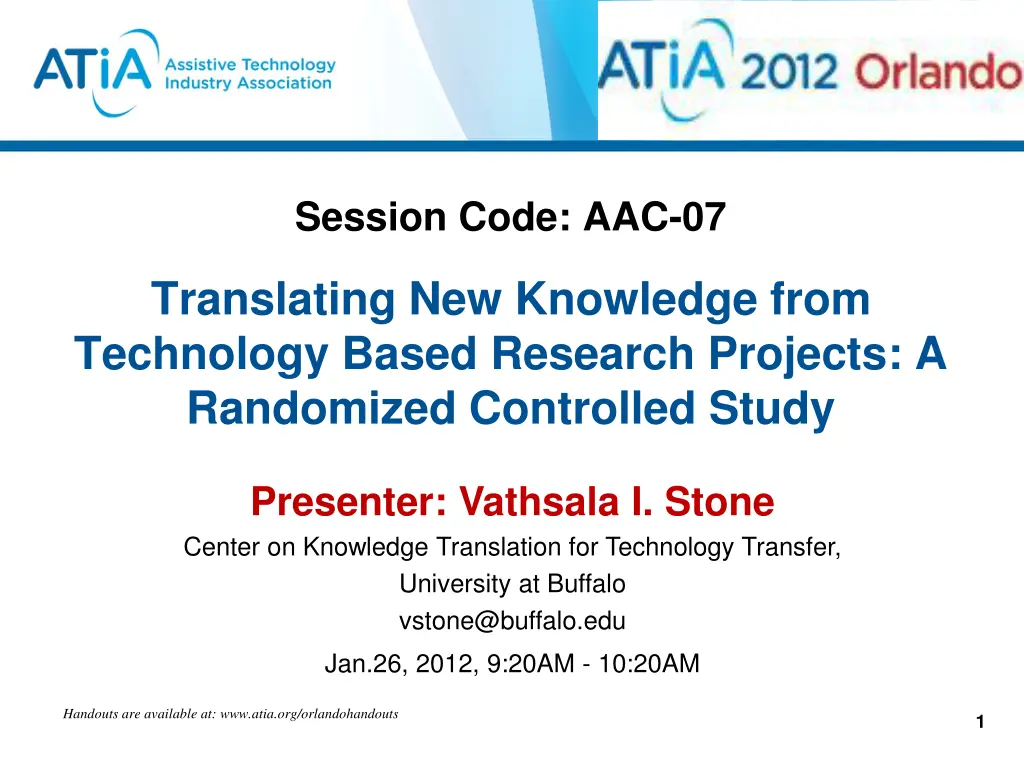
Enhancing Technology-Based Research Impact through Knowledge Translation
Discover how Knowledge Translation for Technology Transfer (KT4TT) bridges the gap between research and practice, focusing on augmentative and alternative communication (AAC) technology. Learn about KT intervention studies aiming to maximize the impact of R&D investments while benefiting persons with disabilities. Funded by NIDRR, this study involves stakeholders like manufacturers, clinicians, brokers, policymakers, researchers, and consumers to improve quality of life through innovative technology solutions.
Download Presentation

Please find below an Image/Link to download the presentation.
The content on the website is provided AS IS for your information and personal use only. It may not be sold, licensed, or shared on other websites without obtaining consent from the author. If you encounter any issues during the download, it is possible that the publisher has removed the file from their server.
You are allowed to download the files provided on this website for personal or commercial use, subject to the condition that they are used lawfully. All files are the property of their respective owners.
The content on the website is provided AS IS for your information and personal use only. It may not be sold, licensed, or shared on other websites without obtaining consent from the author.
E N D
Presentation Transcript
Session Code: AAC-07 Translating New Knowledge from Technology Based Research Projects: A Randomized Controlled Study Presenter: Vathsala I. Stone Center on Knowledge Translation for Technology Transfer, University at Buffalo vstone@buffalo.edu Jan.26, 2012, 9:20AM - 10:20AM Handouts are available at: www.atia.org/orlandohandouts 1
Background Context: Knowledge Translation for Technology Transfer (KT4TT) KT (CIHR, 2004; 2005; 2009; Sudsawad, 2007) Addresses: Under-utilized Research (Weiss, 1979) ; Accountability of funded Research (GPRA; Wholey et al, 2004) Proposed solution: Research-to-practice TT (Lane, 2003) Technology based R&D K Outputs Market Outcomes (products & services) Societal Impact (User Benefits) KT4TT: Links the two processes to increase results. Handouts are available at: www.atia.org/orlandohandouts 2
KT4TT: Example related to Augmentative and Alternative Communication (AAC) technology Knowledge Output: Vocabulary and Symbol Sets for adult users of AAC (Bryen, 2008) Beneficiaries: Consumers with complex communication needs Expected Outcomes: manufacturers transform vocabulary for AAC machines ; clinicians - fit AAC for consumers brokers facilitate use of AAC policy makers regulate the use of AAC Researchers advance the work. Impact: Improved function & quality of life for persons with disabilities. Key: Strategic Communication of New Knowledge to Stakeholders with potential to value and apply, to facilitate implementation and use to benefit society. 3
KT intervention studies: Purpose Problem: Sub-optimal demonstration of impact from R&D investment. Purpose: Develop and evaluate KT intervention strategies that are feasible for use by technology R&D projects and effective in increasing use of new knowledge by potential users (stakeholders). Utility: K producers (technology grantees) can document evidence of impact from their project outputs 4
Relevance of the Study Funding agency: National Institute for Disability and Rehabilitation Research (NIDRR) Beneficiaries: Persons with Disabilities Knowledge Producers: NIDRR s Technology grantees (R&D projects) RERC on AAC Knowledge Users: (6 stakeholder groups) Manufacturers; Clinicians; Transition Brokers; Researchers; Policy makers; Consumers with disabilities 5
Guiding Concepts: The Knowledge-to-Action (KTA) model (Graham, et al, 2006) 6
Guiding Concepts (Contd.) End-of-grant KT and Integrated KT Intervention Study focus end-of-grant outputs from NIDRR s technology grantees. Knowledge Value mapping (Rogers, 2000; Lane and Rogers, 2011) Map needs, expectations and values of K users regarding research, its production and dissemination. Intervention Tailoring of K (Contextualization) Formats of communication (accessible, usable) Multi modal channels of delivery (Sudsawad, 2007). 7
Intervention Study: Overall Design 1. Select End-of-Grant Innovation (completed grantee research study) Inclusion Criteria Quality- peer reviewed publication Innovation - Novel? Feasible? Useful? Selected K in AAC : Research by Bryen (2008) - Vocabulary for Adult users of AAC. 2. Create Intervention Strategy & tools Identify and Interview organizations Prepare Knowledge Value Maps (KVM) for User context, needs, expectations Source of participants Tailored Tools: Six Contextualized Knowledge Packages (CKPs) Six Webinars (training) Technical Assistance upon request 8
Intervention Study: Overall Design 3. Implement Intervention Targeted Dissemination: Recruit K users via organizations. 4. Evaluate Intervention Objective: Evaluate effectiveness of KT strategy for a given new K in AAC field; demonstrate what works for NIDRR and grantees (K producers). Compare Tailored Targeted Dissemination of K (TTDK) with Targeted Dissemination of K (TDK) and Control (traditional diffusion) Measure effects: Awareness, Interest and Use of New Knowledge 9
Intervention Targeted Dissemination of K (TDK) Through stakeholder affiliated organizations Value mapping (Rogers, 2004; Lane and Rogers, 2011) (K user expectations and values regarding research) Recruitment Targeted and Tailored Dissemination of K (TTDK) Relevant audience targeted (as above) Contextualized knowledge Packages (CKPs) Formats of communication (accessible, usable) Multi channel delivery tailored webinar; tailored tech assistance offer 10
Research Questions R1: Are there differences in effectiveness among the 3 methods of communication, i.e., TTDK, TDK and Passive Diffusion, in terms of raising overall levels of K use by stakeholders? R2: Are there differences in change in overall levels of K use among the five types of stakeholders, i.e., brokers, clinicians, manufacturers, researchers and consumers? R3: Do individuals who reach more advanced level of K use have demographic characteristics and knowledge processing traits different from the individuals who do not reach advanced levels? 11
Research Design for the KT Intervention Evaluation Baseline Assessme nt Interventio n Delivery (4 Mo.) Follow/u p Test 1 Interventio n Delivery (4 Mo.) Follow/ up Test 2 R T1 O X1a O X1b O R T2 O X2 O O R C O O O Where T1=group exposed to TTDK; T2=group exposed to TDK; C=Control group; O=Observation (via LOKUS); X1a and X1b are components of TTDK method; & X2= TDK method. 12
Instrument Level of Knowledge Use survey (LOKUS) Web-based survey development (Stone et al, in preparation) I Questions on findings from 3 Studies (A= Bryen s research; B & C = Distracters). Initial framework based on Hall, et al (2006); Measures Awareness, Interest and Use Current model: Levels, Dimensions and Activities Psychometrics (Tomita et al, in preparation) Adequate content validity, exceptional test-retest reliability (1.0), strong convergence with a conventional pencil and paper survey, and solid construct validity to detect changes
Conceptual Model of LOKUS Non-Awareness Awareness Interest Orientation (B, G, S, A, I)* Preparation (B, G, S, P, I) Intended Use Initial Use (G, A, I) Modified Use Collaboration (B, G, S, A, P, I) Expansion (B, G, S, A, P, I) Integration (B, G, A, I) Modification (B, G, A, I) Routine Use (B, A, P, I) *Activities: B: Being Aware, G: Getting Information, S: Sharing, A: Assessing, P: Planning, I: Implementing 14
Sample Size Determined by power analysis Based on study by Miller and Spilker (2003) Needed N=206: for power = .80, 1= .05, and effect size = .24. Planned N=270 considering attrition; [3 study gps. x 6 stakeholder types x 15] Actual N after attrition = 207 ( T1 = 72; T2 = 72; & Control = 63); Including 5 stakeholder types. 15
Recruitment Individuals presumed to have interest in AAC related research findings. Through national organizations of affiliation of Knowledge Users: ATIA - American Technology and Industry Association; ASHA -American Speech and Hearing Association; ISAAC - International Society for Augmentative and Alternative Communication; NCIL national council on Independent Living; AHEAD Association on Higher Education and Disability. List of authors published in AAC research journals (public domain) 16
Inclusion/Exclusion Criteria Included: Is a broker, clinician, consumer, manufacturer or researcher in AAC; belongs to pertinent organization in the AAC field. Consumers of AAC above 18 years of age; Clinicians have clients above 18 years of age; Brokers offer disability services for students; Researchers do AAC related research. Excluded: Online Groups (Aculog) or social networking sites with potential for cross- contamination among participant groups. 17
Study Sample* STUDY GROUP T1 (TTDK) T2 (TDK) Control Total STAKEHOLDER TYPE 23 23 19 65 BROKER 13 15 17 45 CLINICIAN 11 8 7 26 MANUFACTURER 8 7 6 21 RESEARCHER 17 19 14 50 CONSUMER TOTAL 72 72 63 207 *The 3 groups were equivalent in Demographic characteristics ; there were no significant differences in age, years of experience, gender, race/ethnicity, education and work status. 18
RESULTS: Demographic characteristics of participants No difference among participants allocated to the TTDK, TDK and Control groups regarding age, years of experience, gender, race/ethnicity, education and work status. 3 groups were equivalent. Tables 2a, 2b, 2c follow. 19
Table 2a. Sample Characteristics (All : N=207) T1 (TTDK) T2 (TDK) Control Total GROUP Mean (SD) (n=72) Mean (SD) (n=72) Mean (SD) (n=63) Mean (SD) (n=207) Difference F (p=) Age (n=206) 45.21 (11.47) (n=72) 44.93 (12.21) (n=71) 41.68 (11.47) (n=63) 44.03 (11.78) 1.834 (.162) Years of Experience 15.61 (10.99) 13.34 (9.93) 13.40 (10.16) 14.15 (10.38) 1.099 (.335) 20
Table 2b. Sample Characteristics (All : N=207) T1 (TTDK) T2 (TDK) Control Total GROUP Difference 2 (p=) Freq. (%) (n=72) Freq. (%) (n=72) Freq. (%) (n=63) Freq. (%) (n=207) Gender Male Female 14 (19.4%) 58 (80.6%) 19 (26.4%) 53 (73.6%) 11 (17.5%) 52 (82.5%) 44 (21.3%) 163 (78.7%) 1.817 (.403) Race White Black Asian Hispanic Native American Other 67 (93.1%) 2 (2.8%) 0 3 (4.2%) 61 (84.7%) 3 (4.2%) 2 (2.8%) 1 (1.4%) 57 (90.5%) 5 (7.9%) 0 1 (1.6%) 185 (89.4%) 10 (4.8%) 2 (1.0%) 5 (2.4%) 16.776 (.158) 0 0 3 (4.2%) 2 (2.8%) 0 0 3 (1.4%) 2 (1.0%) 21
Table 2c. Sample Characteristics (All : N=207) T1 (TTDK) T2 (TDK) Control Total GROUP Difference 2 (p=) Freq. (%) (n=72) Freq. (%) (n=72) Freq. (%) (n=63) Freq. (%) (n=207) Education <12 year HS 2-year college BS/BA MA/BA Doctorate 2 (2.8%) 8 (11.1%) 1 (1.4%) 11 (15.3%) 38 (52.8%) 12 (16.7%) 1 (1.4%) 7 (9.7%) 3 (4.2%) 8 (11.1%) 39 (54.2%) 14 (19.4%) 1 (1.6%) 5 (7.9%) 2 (3.2%) 11 (17.5%) 37 (58.7%) 7 (11.1%) 4 (1.9%) 20 (9.7%) 6 (2.9%) 30 (14.5%) 114 (55.1%) 33 (15.9%) 4.462 (.924) Work Status Full time Part time Unemployed Not employed 52 (72.2%) 13 (18.1%) 2 (2.8%) 5 (6.9%) 48 (66.7%) 11 (15.3%) 3 (4.2%) 10 (13.9%) 46 (73.0%) 6 (9.5%) 3 (4.8%) 8 (12.7%) 146 (70.5%) 30 (14.5%) 8 (3.9%) 23 (11.1%) 4.107 (.662) 22
Results: Comparative Effectiveness of 3 methods KU Level Means for Study A* at Base, F/up 1, and F/up 2 (N=207 Baseline Mean (S.D.) Follow/up 1 Mean (S.D.) Follow/up 2 Mean (S.D.) Difference (p) Post-hoc test Z (p) New Knowledge from: Base vs F/up1 3.826 (<.001) Base vs F/up1 3.330 (.001) Base vs F/up2 4.297 (<.001) Base vs F/up2 3.206 (.001) T1 Study A (N=72) 1.22 (.68) 1.79 (1.16) 1.69 (1.03) 22.632 (<.001) (TTDK) 1.26 (.77) 1.76 (1.19) T2 (TDK) 1.74 (1.16) 13.884 (.001) Study A (N=72) 1.38 (.97) 1.51 (1.05) 1.73 (1.22) 6.484 (.039) Control Study A (N=63) Both TTDK and TDK moved up significantly in K Use levels from baseline. They differed from the Control group, but not between each other. 23
Results Mean Change in KU Level: Differences among Three Groups for Study A* (All; N=207) Difference 2 (p) T1(TTDK) Mean (S.D.) T2(TDK) Mean (S.D.) Control Mean (S.D.) KU Level Change .57 (1.12) .50 (1.17) .13 (1.01) 7.044 (.030) Baseline to F/up 1 .47 (.82) .47 (1.19) .35 (1.19) 2.371 (.306) Baseline to F/up 2 -.10 (1.20) -.03 (.75) .22 (1.13) 3.443 (.179) F/up 1 to F/up 2 K Use level changes were significantly different among the 3 groups from baseline to Follow/up 1. 24
Table 5a. Freq. comparisons between Baseline and F/Up1 reg. Non-Awareness/ Awareness+ (McNemar Test ;N=207) T1Group- TTDK (N=72) Follow/UP 1 Total Non- Awareness + Exact Sig. (2-sided p=) Awareness Non-Awareness 44 19 63 Baseline .001 Awareness+ 2 7 9 Total 46 26 72 (100%) 25
Table 5b. Freq. comparisons between Baseline and F/Up1 reg. Non-Awareness/ Awareness+ (McNemar Test ;N=207) T2Group- TDK (N=72) Follow/UP 1 Exact Sig. (2-sided p=) Non-Awareness Awareness+ Total 46 17 63 Non-Awareness .001 Baseline 2 7 9 Awareness+ 48 24 72 (100%) Total 26
Table 5c. Freq. comparisons between Baseline and F/Up1 reg. Non-Awareness/ Awareness+ (McNemar Test ;N=207) Control Group N=63 Follow/UP 1 Awareness+ Total Non- Exact Sig. (2-sided p=) Awareness 48 6 54 Non- .289 Baseline Awareness 2 7 9 Awareness+ 50 13 Total 63 (100%) 27
Table 6. Frequency Comparisons between Baseline & F/Up1 reg. Non-Use/Use (McNemar Test: N=207) Follow/UP 1 T1 TTDK (Study-A: N=72) Non-Use Use Total Exact Sig. (2-sided p=) 59 2 61 10 1 11 69 3 72 Non-Use Use Total .039 Baseline Follow/UP 1 T2 TDK (Study-A:N=72) Non-Use Use Total Exact Sig. (2-sided p=) 57 11 68 Non-Use .022 Baseline 2 2 4 Use 59 13 72 Total Follow/UP 1 Control (Study-A:N=63) Non-Use Use Total Exact Sig. (2-sided p=) 52 4 56 4 3 7 56 7 63 Non-Use Use Total 1.000 Baseline 28
Summary of Results: Research Question 1 1. TTDK and TDK were effective in terms of change in level of K use. (Table 3) 2. Both TTDK and TDK were effective in raising K use level from Non-Awareness to Awareness and beyond (Tables 5a, 5b, 5c); as well as from Non-Use to Use (Table 6). Cell frequencies and exact levels of significance suggest TTDK and TDK were more effective in terms of raising awareness than in terms of moving non-users to use. 3. Analysis of these level changes (Table 4) showed TTDK and TDK more effective than passive diffusion method (control) from Baseline to Follow/up 1, but neither between Follow/up 1 and Follow/up 2, nor between baseline to Follow/up 2. 29
RESULTS: Differential effects among stakeholders N Mean SD Kruskal Wallis Total change in Level P Mean (SD) Broker Clinicians Manufacturers Researchers Consumers Total Broker Clinicians Manufacturers Researchers Consumers Total Broker Clinicians Manufacturers Researchers Consumers Total 23 13 11 .26 .46 .64 1.00 .82 .57 .04 .62 1.00 .63 .53 .47 -.22 .15 .36 -.38 -.29 -.10 .915 .967 1.567 1.195 1.131 1.124 .367 .768 1.000 1.061 .874 .822 .902 1.144 1.120 1.685 1.404 1.200 Baseline to F/Up 1 4.883 (.300) .57 (1.12) 8 17 72 23 13 11 Baseline to F/Up 2 13.087 (.011) Broker vs. Manuf. .47 (.82) 8 17 72 23 13 11 F/Up 1 to F/Up 2 5.333 (.255) -.10 (1.2) 8 17 72 30
Table 7b. Level Change Differences among Stakeholder Types: T2 (TDK) N Mean change in SD Kruskal Wallis Total Level .26 .33 .50 .43 .95 .50 .13 .40 .38 .43 1.00 .47 -.13 .07 -.13 .00 .05 -.03 P Mean (SD) Broker Clinicians Manufactures Researchers Consumers Total Broker Clinicians Manufactures Researchers Consumers Total Broker Clinicians Manufactures Researchers Consumers Total 23 15 .752 1.234 1.604 .787 1.433 1.175 .626 1.183 1.598 .976 1.491 1.186 .458 1.033 .354 1.000 .848 .750 Baseline to F/Up 1 2.630 (.623) .50 (1.18) 8 7 19 72 23 15 Baseline to F/Up 2 4.045 (.400) .47 (1.19) 8 7 19 72 23 15 F/Up 1 to F/Up 2 3.343 (.502) -.03 (.75) 8 7 19 72 31
Table 7c. Level Change Differences among Stakeholder Types : CONTROL Group N Mean change in Level SD Kruskal Wallis P Total Mean (SD) Baseline to F/Up 1 Broker Clinicians Manufactures Researchers Consumers Total Broker Clinicians Manufactures Researchers Consumers Total Broker Clinicians Manufactures Researchers Consumers Total 19 17 .16 .29 -.57 -.17 .36 .13 .16 .24 -.14 1.33 .57 .35 .00 -.06 .43 1.50 .21 .22 .688 .849 1.134 .408 1.499 1.008 .501 .752 1.773 1.506 1.651 1.194 .882 1.197 1.272 1.378 .893 1.128 7.527 (.111) .13 (1.10) 7 6 14 63 19 17 Baseline to F/Up 2 6.614 (.158) .35 (1.19) 7 6 14 63 19 17 F/Up 1 to F/Up 2 9.262 (.055) .22 (1.13) 7 6 14 63 32
Summary of Results - Research Question 2 From baseline to Follow/up 1 and from Follow/up 1 to Follow/up 2, there were no differences among stakeholders (Tables 7a, 7b and 7c). However, a significant difference was identified between brokers and manufacturers between Baseline and Follow/up 2 for the TTDK group only. Manufacturers moved up the most and brokers the least (Table 7a). 33
Results (Contd.) Table 8a. Change in Level from Baseline to F/Up 1 and participant characteristics TTDK on Study A: (N=72) Levels N Mean Difference U (p) 580.0 (.381) Standard Deviation 1.152 1.094 1.122 1.134 1.251 1.096 1.078 1.517 1.221 1.105 44 45 35 37 38 34 14 58 67 5 11 61 .71 .43 .66 .47 .79 .52 .51 1.40 .91 .51 Age 607.0 (.612) Years of Experience Gender 14 15 Male Female Majority Minority 359.0 (.441) 105.0 (.175) Race 270.0 (.237) Education 2 Years College BS/BA Full Time Not Full Time Non-Awareness Awareness + 52 20 63 9 .46 .85 .30 -.22 1.093 1.182 .463 .441 430.0 (.192) Work Status 154.0 (.005) Baseline Level Change in K Use was more for the non-aware participants. 34
Results (Contd.) Table 8b. Baseline to F/Up 1 Change in Level and participant characteristics: TDK on Study A: (N=72) Levels 44 45 14 15 Male Female Majority Minority N 39 32 44 28 19 53 61 11 11 61 Mean .56 .34 .20 .96 .63 .45 .52 .36 1.36 .34 S.D. 1.119 1.181 .878 1.427 1.165 1.186 1.219 .924 1.433 1.063 Difference U (p) 580.0 (.534) Age (n=71) Years of Experience Gender 430.5 (.009) 470.5 (.610) 319.0 (.755) Race 203.0 (.012) Education 2 Years College BS/BA Full Time Not Full Time Non-Awareness Awareness + 48 24 63 9 .44 .63 .27 -.22 1.201 1.135 .447 .441 519.5 (.414) Work Status 161.0 (.007) Baseline Level In the TDK group, change in K Use was more for the more experienced, the less educated and the non-aware . 35
Summary of Results - Research Question 3 Participants in the TTDK group who were at the Non- Awareness level regarding Bryen s findings at baseline moved up significantly more than participants who were at Awareness and above (Table 8a). In the TDK group, participants who were at the Non- Awareness level for Bryen s findings at baseline moved up significantly to Follow/up 1 more than others. Additionally, those who had lower education levels (<2year-college), and those with more years of experience (15 yrs or more) moved up significantly more than the others in these characteristics (Table 8b). 36
Conclusions Conclusions are tentative; replication RCTs are underway. 1. Targeting stakeholders for dissemination (common component of TTDK and TDK) is an effective way to raise K use; although Tailoring did not add to KT effectiveness. 2. Within TTDK, the tailored CKP was effective (intervention between baseline and Follow/up 1); however, the tailored webcast was not(intervention between Follow/ups 1 and 2). 3. Both TTDK and TDK were more effective in moving stakeholders beyond non- awareness than in moving non-users to use. (Approx. 30% Vs. 15%) 4. No differential effects on stakeholders except brokers vs. manufacturers for TTDK. Suggests that tailoring the K (in AAC) might hold most value for manufacturers in this field, and least for brokers (K use facilitators in academic environment) 5. Both TTDK and TDK strategies were more effective with those who are at the Non- awareness level. Corroborates earlier conclusion #3. 6. The TDK (disseminating the original article about K with no CKP) was more effective in raising awareness of those with lower educational level and those who were more experienced working with AAC. 37
Discussion Conclusions are tentative, and replication is desirable. Replication studies should consider effects of CKP vs. webcast/Tech assistance. Did the order of intervention play a role? Did the duration of intervention play a role? Nevertheless, the main results are not surprising. End-of-Grant KT (evaluated in this study) assumes audience have needs for the K generated; proposes finding the problem for which the K could be a solution. The opposite is argued in the Prior-to-grant KT approach proposed in the NtK model (Lane & Flagg, 2010). Based on Project s TT experience; Need should be validated prior to initiating any technology based R&D project. Future RCTs to test this may shed further light. 38
A KT Framework for Technology Based Innovations Need to Knowledge (NtK) Model (Lane and Flagg, 2010) http://kt4tt.buffalo.edu/knowledgebase/model.php Need & Envisioned Solution Impact on Beneficiary R D P KtA KtA KtA 3 processes; 3 states of K; 3 outputs Introduces Prior-to-grant KT 39
Discussion: Evaluation Quality Intervention Evaluation considered professional Standards Utility: Effective KT strategy for use by grantee; specific feedback from K users for strategy refinement. Feasibility KT strategy conceptualized from grantee perspective, & replicated for different technology outputs. Accuracy RCT design (merit) + follow up (worth). Propriety involve K producer (grantee) in translation. Evaluation considered both rigor and relevance as important for KT: Is the K credible? --- Merit (rigor) of evidence (Peer reviewed publication) Is the K worthy? --- Relevance to K users (Review Committee of Stakeholders) 40
Acknowledgement This is a presentation of the KT4TT Center which is funded by the National Institute on Disability and Rehabilitation Research of the U.S. Department of Education, under grant number H133A080050. The opinions contained in this presentation are those of the grantee and do not necessarily reflect those of the U.S. Department of Education. We also acknowledge collaboration and expert input from the RERC on Communication Enhancement during the implementation phase of the study. 41
Key References 1. Bozeman, B., & Rogers, J. D. (2002). A churn model of scientific knowledge value: Internet researchers as a knowledge value collective, Research Policy, 31, 769-794. 2. Bryen D. N. (2008). Vocabulary to Support Socially-Valued Adult Roles. Augmentative and alternative Communication, Vol. 24, No. 4, Pages 294-301 3. CIHR. About knowledge translation. Retrieved October 25, 2009, from http://www.cihr-irsc.gc.ca/e/29418.html 4. Graham, I.D., Logan, J., Harrison, M.B., Straus, S.E., Tetroe, J., Caswell, W., & Robinson, N. (2006). Lost in translation: time for a map? The Journal of Continuing Education in the Health Professions, 26(1), 13-24. 5. Hall, G.E., Dirksen, D.J., and George, A.A. (2006). Measuring Implementation in Schools: Levels of Use. Austin, TX: Southwest Educational Development Laboratory (SEDL). 6. Lane JP (ed.) (2003. The science and practice of technology transfer: implications for the field of technology transfer, Journal of Technology Transfer: 28, 3/4, 333-354 7. Lane, JP and Flagg JL(2010). Translating three states of knowledge--discovery, invention, and innovation, Implementation Science 2010, 5:9. 8. Lane, JP and Rogers JD (2011). Engaging national organizations for knowledge translation: comparative case studies in knowledge value mapping, Implementation Science 2011, 6:106. 9. Rogers, J.D. (2000). Theoretical consideration of collaboration in scientific research. In J.S. Hauger and C.McEnaney (Eds.), Strategies for competitiveness in Academic Research (Chapter 6). 10. Stone VI. (2010). Translating Knowledge from Technology based research projects: an end-of-grant intervention evaluation study rationale and methods. AEA 2010 annual meeting, Nov. 10-13, San Antonio, Tx. 11. Stone VI and Colleagues. Development of LOKUS. (Manuscript in preparation ) 12. Sudsawad, P (2007). Knowledge Translation: Introduction to Models, Strategies, and Measures. Austin: Southwest Educational Development Laboratory, National Center for the Dissemination of Disability Research. (p.4; 21-22) 13. Tomita, MR, Stone VI and Telang SR. Psychometric Properties of LOKUS. (Manuscript in preparation ) 14. Weiss, C H (1979). The Many Meanings of Research Utilization. Public Administration Review, 39(5): 426-431. 15. Wholey J S., Hatry H P., and Newcomer, K E (eds.) (2004). Handbook of Practical Program Evaluation, San Francisco: Jossey-Bass. 42
Thank you for attending this session CEUs Session Code: AAC-07 More info at: www.atia.org/CEU For ACVREP, AOTA and ASHA CEUs, hand in completed Attendance Forms to REGISTRATION DESK at the end of the conference. For general CEUs, apply online with The AAC Institute: www.aacinstitute.org Session Evaluation Please help us improve the quality of our conference by completing your session evaluation form. Completed evaluation forms should be submitted as you exit or to staff at the registration desk. Handouts Handouts are available at: www.atia.org/orlandohandouts Handout link remains live for 3 months after the conference ends. Handouts are available at: www.atia.org/orlandohandouts 43


